Schwerin
![]()
The title of this article is ambiguous. For other meanings, see Schwerin (disambiguation).
Schwerin ([ʃvɛˈʁiːn] or [ʃvəˈʁiːn], Mecklenburgish Swerin) is the state capital of Mecklenburg-Vorpommern. The county-free medium-sized city is the smallest of all state capitals in Germany. Schwerin is the second largest city after Rostock and one of the four major centres of the state.
Schwerin was first mentioned in 1018 as Wendenburg and received German city rights from Henry the Lion in 1164. This makes it the oldest city in what is now Mecklenburg-Vorpommern. In the course of time, the town expanded along the western and southern shores of Schwerin's inner lake, and a total of twelve lakes are located within the town's area. The starting point of the city's development was the site of the city's current landmark, Schwerin Castle; it is located on an island between Schwerin Lake and Burgsee with the castle church dating from 1560. The castle was a main residence of the dukes and grand dukes of Mecklenburg until 1918 and the centre of power of the Duchy of Mecklenburg-Schwerin, which became a democratic Free State in 1919. Since 1990, the palace has been the seat of the state parliament. With its surrounding gardens, it was the main venue for the 2009 Federal Garden Show and, as a historically unique ensemble with the other residential buildings, is a candidate for UNESCO World Heritage status. In addition, Schwerin is characterized by its old town - unusually well preserved for a German city of this size - the adjacent Schelfstadt, the Zippendorf spa district and other historic districts with many architectural monuments.
The economy is dominated by technology companies, public authorities, Deutsche Bahn (German Railways), mechanical engineering and materials processing, consumer production, the health industry and clinics, service companies, and increasingly also tourism and the cultural and creative industries. In addition, Schwerin is a university location with around 600 students, including the private University of Applied Sciences for SMEs, the University of the Federal Employment Agency and the Vitruvius Design University. In terms of sports, Schwerin has been known as a boxing city since Fritz Sdunek and as a volleyball city through the twelve-time German champion Schweriner SC.
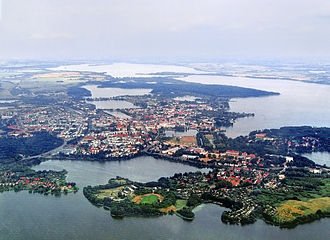
Aerial view of Schwerin
Overview
Schwerin is located in the west of the state of Mecklenburg-Western Pomerania on the southwestern shore of Lake Schwerin in a densely wooded lake landscape. Other lakes in the city area are the Burgsee, the Faule See, the Grimkesee, the Heidensee, the Große Karausche, the Lankower See, the Medeweger See, the Neumühler See, the Ostorfer See, the Pfaffenteich and the Ziegelsee. Flowing waters are the Aubach, whose water feeds Lake Schwerin via the connection of several lakes, and the Stör, the natural outflow of Germany's fourth largest lake, which has been developed into a waterway.
The inhabitants like to call Schwerin the "city of seven lakes and forests". This designation goes back to a time when Schwerin did not yet have its current geographical extent and was actually surrounded by only seven lakes. The extensive forests had to gradually give way to urban development, numerous remnants of forest have been preserved, especially on the shores of the lakes. Of the 130.46 km² city area, 28.9 percent is covered with water and 18.5 percent with forest. The height of the city above sea level is 38 metres on the shores of Lake Schwerin and 86.1 metres on the vineyard in the Neumühle district.
The nearest larger cities are Lübeck, about 54 kilometres to the northwest, the regional centre Rostock, about 69 kilometres to the northeast, and Hamburg, about 94 kilometres to the west. In terms of spatial planning, the regional centre of Schwerin belongs to the West Mecklenburg region (with Wismar as an important centre on the Baltic coast); it became part of the Hamburg metropolitan region in 2016.
Neighboring communities
The city of Schwerin borders the following municipalities (clockwise, starting in the northeast on the eastern shore of Lake Schwerin):
- in the Landkreis Ludwigslust-Parchim: Leezen, Raben Steinfeld and Plate (Amt Crivitz), Lübesse (Amt Ludwigslust-Land), Holthusen, Pampow, Klein Rogahn and Wittenförden (all Amt Stralendorf)
- in the district of Nordwestmecklenburg: Brüsewitz, Pingelshagen, Klein Trebbow, Seehof and Lübstorf (Amt Lützow-Lübstorf)
City breakdown
Pursuant to § 11 (2) of the main statutes, Schwerin's urban area is currently divided into 17 districts, each with a local advisory council. The local districts consist of one or more city districts. The local advisory councils have between 5 and 15 members, depending on the number of inhabitants. They are appointed by the city council after each local election for the duration of the election period of the city council. The local advisory councils are to be heard on important matters affecting the local district and have a right of initiative. The final decisions, however, are made by the city council of the entire city.
The 17 current districts with their associated neighborhoods:
- District 1: Schelfstadt, Werdervorstadt, Schelfwerder
- District 2: Old town, Feldstadt, Paulsstadt, Lewenberg
- District 3: Großer Dreesch (former Dreesch I)
- District 4: Neu Zippendorf (former Dreesch II)
- District 5: Mueßer Holz (former Dreesch III)
- District 6: Gartenstadt, Ostorf (former Haselholz, Ostorf)
- District 7: Lankow
- District 8: Weststadt
- District 9: Krebsförden
- District 10: Wüstmark, Göhrener Tannen
- District 11: Görries
- District 12: Friedrichsthal
- District 13: Neumühle, Sacktannen
- District 14: Warnitz
- District 15: Wickendorf, Medewege
- District 16: Zippendorf
- District 17: Mueß
South of the Neumühle district is an enclave of about 12 hectares belonging to the Klein Rogahn municipality.

![]()
Geology
Schwerin is located north of an ice margin of the Weichselian glaciation. The relief was shaped by different phases and stages of the Brandenburg stage of the Vistula glaciation. There are dome-shaped ground and terminal moraine ranges in the western part and an outwash area in the south and east of the city. The elevations of the terminal moraine in the west reach 86.1 m above sea level at Neumühle.
Some of the lakes, such as Lankower See and Neumühler See, were formed after the ice receded from former meltwater channels that were permanently filled with water.
Lake Schwerin lies in a pre-Pleistocene depression that extends from Wismar to the Lewitz. The water body was formed as a tongue basin during the Frankfurt phase of the Weichsee Ice Age. The glacial gate with meltwater discharge in the direction of the Elbe glacial valley existed in the area of Mueß. Later glacial phases left behind moraine material in the lake, such as at the level of the Pauls Dam, which separates the inner and outer lakes, as well as the lakes that lie nearby today, such as the Ziegelsee.
See also: Category:Lake in Schwerin
Climate
Schwerin has a temperate climate. The annual average temperature from 1961 to 1990 was 8.4 °C. The difference between the mean temperature of the warmest and coldest month was 17.2 degrees. On average, 621 millimetres of precipitation fell per year and per square metre. Compared to northwestern Germany, spring is cooler due to harsh northeast winds. The summer heat is mitigated by the proximity of the Baltic Sea, this body of water has a warming effect in autumn.
| Schwerin | ||||||||||||||||||||||||||||||||||||||||||||||||
| Climate diagram | ||||||||||||||||||||||||||||||||||||||||||||||||
| ||||||||||||||||||||||||||||||||||||||||||||||||
| Monthly average temperatures and precipitation for Schwerin
Source: | ||||||||||||||||||||||||||||||||||||||||||||||||||||||||||||||||||||||||||||||||||||||||||||||||||||||||||||||||||||||||||||||||||||||||||||||||||||||||||||||||||||||||||||||||||||||||||||||||||||||||||||||||||||||||||||||||||||||||||||||||||||||||||||
![]()
![]()
Panorama, taken from the Schwerin cathedral in the old town (single objects with links)

Historic old town around the cathedral
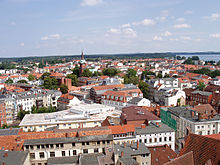
Schelfstadt, a central district of Schwerin with its own old town centre
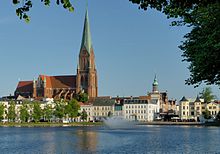
View from the Pfaffenteich to the Schwerin Cathedral and the surrounding Old Town

Schwerin Castle, landmark of the city and Mecklenburg-Vorpommern as well as seat of the state parliament, was built on its own island in Lake Schwerin.
History
Name declarations
The town was first mentioned around 1012/18 as Zuarina by Thietmar of Merseburg. Helmold of Bosau called it Zuerin, Zwerin in 1160. The Pöhlder annals call the place Zuarin (-ensis) in 1160 and the Steterburger Zvarin in 1174. Since the 15th century the place was called Swerin (still common in the Mecklenburg dialect), and since the 16th century Suerin or officially Schwerin.
An indirect first mention could have been earlier: a travel report by the chronicler Ibn Jacub/Ibrahim Ibn Yaqub, envoy of the Caliph of Córdoba (Spain), mentioned a Slavic castle around 973, which could be identical with Schwerin.
The name is said to be related to Polabian zvěŕ for wild animal or zvěŕin for game preserve, zoo or horse stud. Speculations about a descent of the place name from the Slavic god Svarog (Swarzyn, place of Svarog) are not provable.
Deviating from this, it was derived from the Old Germanic swaran (defend, stem-related to swear), which may have been reinterpreted later by immigrating Slavs in the sense of zvěŕ.
Also the Latin name Suerina or Suerinum was and is used for Schwerin.
The main statute of the city of Schwerin determines the designation "state capital" as name addition before the city name.
Settlement, town foundation and county
Today's city area was settled early on. During excavations on Schwerin's Marienplatz, tools were found that have been dated to around 1000 to 600 BC. A subsequent Germanic settlement is attested by the discovery of a well from the 1st century AD.
After 700 AD, Slavs settled in the area of present-day Schwerin. In 965, the Jewish-born Spanish-Moorish traveling salesman Ibrāhīm ibn Yaʿqūb reported on a castle in a freshwater lake, which historians assume to be on the site of present-day Schwerin. Excavation finds on the castle island confirm at least the existence of a Slavic castle rampart during this period. It could be dated dendrochronologically to 941/942. In 1018 the Christian Abodrite prince Mistislaw rescued himself from an attack by the Lutizes in Schwerin Castle, which he subsequently had to abandon.
In 1160, the Abodrite prince Niklot burned down the castle on the castle island to prevent it from falling into the hands of an advancing Saxon army led by Henry the Lion. After defeating Niklot, the Saxon duke had the castle rebuilt as a Saxon outpost in the Abodrite lands. 1160 is therefore traditionally regarded as the "German" year of Schwerin's foundation, although the granting of city rights probably did not take place until 1164. After the death of Niklot, Henry the Lion made Gunzelin I governor over the land of the Abodrites, and thus also over Schwerin. Later Henry divided the land, returned one part to Pribislav, the son of Niklot, and from the other part founded the county of Schwerin with Gunzelin as the first count of Schwerin. In 1167 Schwerin became the seat of the county of Schwerin. In 1167 the Cistercian monk Berno moved his episcopal see to Schwerin. After the consecration of the first cathedral founded by Heinrich around 1171, Schwerin developed into the starting point for the Christianisation of what later became Mecklenburg. At that time the town had about 500 inhabitants, one fifth of whom were clergymen.
A town council, consisting of six aldermen and the mayor, was first mentioned in 1228. The development of the town was hindered by power disputes between the count and the bishop. Until 1284, successors of the bishop were able to take possession of the entire Schelfe (today: Schelfstadt), but this was not included in the urban fortifications, so that the cathedral chapter could not increase its possessions. In 1270 the construction of a second cathedral was begun. The money for this came from the income of pilgrims who sought out a drop of holy blood encased in jasper, which Count Heinrich von Schwerin had brought back from a pilgrimage in 1222 and donated to the canons. At the instigation of the Count's widow, Countess Audacia, a third of the proceeds from this relic was used to finance the construction of a new Franciscan convent, which was mentioned in documents as early as 1236; it is thus the oldest branch of a mendicant order in Mecklenburg (dissolved in 1552). The replacement of the wooden town fortification by a solid town wall was completed in 1340. In 1351 the town hall was mentioned for the first time, which burned down three times and was always rebuilt on the same spot. The medieval archway of the town hall passageway has been preserved. The city wall passed its first test when Duke Albrecht II, a descendant of Niklot, besieged the city for months in 1358.
Mills in Schwerin
→ Main article: Bishop's Mill (Schwerin)
The first bishop's mill was mentioned in 1178. They belonged to the oldest mills in Mecklenburg. However, there were several other mills on the Aubach after that, which also bore this name. In
1284 the Spieltordamm was built, which dammed up the
Aubach in the Mühlenteich, today's Pfaffenteich, and was a prerequisite for the operation of a water-driven count's inland mill Schwerin.
Numerous mills have been mentioned in documents for Schwerin since the 12th century. The mill in Mühlenstraße from 1711 was moved to the outskirts of Schwerin Wismarer Chaussee in 1749 due to unfavourable wind conditions and was demolished in 1893. Until 1866 the so-called Mühlenzwang (also called Mahlzwang) also applied in Schwerin. This meant that grain producers were not allowed to have their grain milled wherever they wanted, but had to have it processed into flour in their respective milling district. When the old compulsory milling law was abolished in 1867 with the adoption of the trade regulations of the North German Confederation of 1868/69 and the millers had lost their monopoly position in their district, the number of mills in the city grew by leaps and bounds in the second half of the 19th century, and because the introduction of the freedom of trade also favoured this process, the great era of windmill construction began in Schwerin. Between 1890 and 1895 there was one watermill, five windmills and three steam mills in Schwerin. After that the decline began; some mills had to be demolished due to dilapidation, others burnt down. Towards the end of the First World War, only the Bischofsmühle and the Schleifmühle Schwerin still existed as water mills.
In the Duchy of Mecklenburg until the 18th century
After the Gunzelin family died out, the county of Schwerin passed to the Duchy of Mecklenburg in 1358. Albrecht II acquired the city for 20,000 marks of silver (which he did not pay in full, however) and made it his residence and thus the cultural and political centre of Mecklenburg. Schwerin also became a provincial town in Mecklenburg and was represented at provincial assemblies as part of the towns of the Mecklenburg district until 1918.
In economic terms, the cities of Rostock and Wismar, which were more conveniently located in terms of transport, developed better. Under Duke Heinrich IV border disputes, robbery and murder were the order of the day, the coffers were empty. In addition, the plague was rampant.
Only Magnus II was able to turn the tide from 1478 onwards by reorganising the administration, especially the financial administration. He had plans to connect the Elbe, Elde, Schwerin Lake and Wismar by canals. Under him, the oldest surviving building in the city was erected, the Great New House. A princely school was opened opposite the palace in 1553, to which the Fridericianum Schwerin is traced. In 1561 a government library was built under Tilemann Stella. The fires of 1531 and 1558 destroyed large parts of the city. By order of the building police, houses had to be built of stone to reduce the fire hazards. However, another fire in 1651 again reduced large parts of Schwerin to rubble. The rebuilding of the town hall was completed in 1654. During the Thirty Years' War, the city suffered relatively fewer losses than the duchy.
Witch hunt
Between 1560 and 1700, around 4000 people were accused of witchcraft in Protestant Mecklenburg, a core zone of the witch hunt, about half of whom were executed. In Schwerin, too, witch trials took place time and again during this period, with the intensity of the persecution increasing significantly after the Thirty Years' War. The interrogations took place in the town hall at the market, in the castle and in the house of the executioner in the Burgstraße. From 1564 to 1770 there are reports of 103 witch trials, probably 45 accused were executed. One woman died under torture. Possibly seven reprimands were issued, two defendants managed to escape.
Between 1665 and 1669 alone, 19 alleged witches were arrested in the city. Almost all of them were executed and burned after short but extremely brutal interrogations and such forced confessions. Since the tortured women also gave the names of other witches to the court, regular chain trials developed. In 1604, several women from Schwerin were accused of being witches and of having caused the death of the young Duke Johann VII by witchcraft in 1592, among them Catharina Wankelmod (Katharina Wankelmut), who was later burned at the stake, and Margarethe Schultze, who was acquitted in 1609 after a trial lasting five years. Children were also among the victims in Schwerin. In 1642, eight-year-old Hans Donken (Hans Douke) was flogged for sorcery. Asmut Veith was even beheaded at the age of fourteen.
Since 1986, this dark side of the city's history has been commemorated by a relief plaque by the sculptor Anni Jung on the ceramic column erected on the Great Moor. On 18 April 2016, the city council decided to rehabilitate the victims of the witch hunt in Schwerin and to install a memorial plaque near the town hall.
18th century
According to a ducal order of 1705, the expansion of today's Schelfstadt took place. In 1717 the few Jews, who had been allowed to settle there again since 1679, established a cemetery there. In 1740 the town hall of Schwerin's new town was built, initially as a residential building, and in 1776 it was converted into an administrative centre. The attempt to establish trade and commerce and to revitalize the city failed due to the backward economy caused by the dominance of the nobility and the knighthood.
In 1752, 200 lanterns already illuminated the streets of Schwerin. The development of the suburb continued. Duke Friedrich moved the residence from Schwerin to Ludwigslust from 1756 to 1765, where it remained until 1837. In 1759 Prussian troops occupied the country and also besieged Schwerin. In 1764 there were 3288 inhabitants in Schwerin's old and suburbs. In 1773 the synagogue was consecrated, in the neighbourhood of which residential houses for the state rabbi and the cantor were built.
Between 1783 and 1785 the New Building was erected on the market as a market hall according to Johann Joachim Busch's designs. It replaced open market stalls with poor hygienic conditions on the open space between four old, irregular estates. During his visits to Schwerin, Duke Friedrich disliked the stench of the market and the shrieking of the market women.
19th century to Weimar Republic
From September 1813, the Dreesch was used by the Russian-German Legion as a training ground for the liberation struggle against Napoleon.
The townscape was changed in the 19th century by extensive building measures. Schwerin lost its medieval character and expanded further. City fortifications that were no longer needed disappeared, stone and half-timbered buildings gradually replaced wooden huts. Building on the Great Marsh proved to be a difficult undertaking in the swampy subsoil. New buildings were erected on Marienplatz and in Rostocker Straße (today: Goethestraße), and from 1824 to 1834 Friedrich Franz I erected a new seat of government in Schloßstraße (Schwerin) and other buildings. By 1836 the town hall had been transformed into a representative building by the court architect Georg Adolf Demmler, the theatre at the Old Garden and the Marstall on the Marstall Peninsula were built. In the north of Schwerin, northern Germany's first scientifically run insane asylum was built on the Sachsenberg.
After the ducal residence was moved back from Ludwigslust to Schwerin under Grand Duke Paul Friedrich in 1837, it was decided to completely rebuild Schwerin Palace due to its poor structural condition. Demmler's designs, which were based on French Renaissance palaces, met with the approval of the sovereign, who, however, died in 1842, whereupon the new Grand Duke Friedrich Franz II put a stop to the new building. The old palace was thoroughly renovated and partially rebuilt from 1845 to 1857, but from 1851 onwards under the direction of the Berlin architect Friedrich August Stüler and with the participation of Hermann Willebrand, after Demmler had come into conflict with court officials.
The Arsenal on the Pfaffenteich was built on the south-west bank of Schwerin's Pfaffenteich between 1840 and 1844 to a design by Demmler under the construction supervision of Hermann Willebrand and Gottlieb Ruge. It was first used as an armoury and after the First World War as police barracks. In 1842 the Paulsdamm was built through the Schwerin lake. The Jewish community grew to 300 members, and in 1825 the synagogue was renovated from the ground up and expanded several times.
In 1847, the town was connected to the Berlin-Hamburg railway line, which passed far to the south of the town, by a railway connection to Hagenow. In 1852 the first steamboat sailed from Zippendorf to Kaninchenwerder Island.
In April 1882, the theatre originally built by Demmler burned down during a performance. The new building was designed by court architect Georg Daniel and completed between 1883 and 1886. On the day of its opening on 3 October 1886, the new building represented one of the most advanced theatre structures in the world at the time. Between 1889 and 1890, the station building in the style of the Gründerzeit was built on the site of several previous buildings, and has remained largely unchanged except for alterations in the 1920s. In 1904 the power station was built on the north bank of the Pfaffenteich. An electric tram ran from 1908.
The first German round trip flight in 1911, in which the royal city was a staging post, provided the impetus for the construction of the Schwerin-Görries airfield. In November 1912 the "Mecklenburgische Flugplatz-Gesellschaft Görries-Schwerin mbH" was founded. By Easter 1913, the airfield company had the selected tournament field in Görries levelled and fenced in and had a spectator stand, a restaurant and an aircraft hangar built by the Berlin architect Richard Thiede. The aircraft builder Anton Herman Gerard Fokker moved his company Fokker Aeroplanbau from Berlin-Johannisthal to Schwerin in 1913 and built his factory halls in Bornhövedstraße, among others. There also the Fokker Dr.I was built. As a result of the Versailles Treaty, aircraft production had to be discontinued in 1919.
Also in 1913, a fire destroyed the Golden Hall of Schwerin Palace.
As a result of the First World War there were social and political tensions. Hunger and need moved young people and women to break into slaughterhouses and bakeries to get food. In 1918, many workers went on strike. In 1918, Grand Duke Friedrich Franz IV abdicated and Social Democracy was able to establish itself more firmly in the capital of the new Free State of Mecklenburg-Schwerin.
As a result of the provisions of the Treaty of Versailles, the aircraft manufacturer Fokker left its company site in Schwerin in 1919.
From 1919 to 1933, the State Theatre served as the first democratic parliament and state assembly of the Free State of Mecklenburg-Schwerin. In 1920, 15 workers were killed near the Arsenal in bloody clashes with Kapp putschists.
The National Socialist era 1933-1945
In 1932, the NSDAP achieved a narrow absolute majority in the state elections in Mecklenburg-Schwerin and from then on provided the state government. In 1933, SPD and KPD functionaries were persecuted and arrested, and the mayor and the heads of public institutions were dismissed. Friedrich Hildebrandt was appointed Reich Governor of Mecklenburg. In the same year there were book burnings in the city. In 1934 Schwerin became the capital of the Gau Mecklenburg, which was formed by the merger of the Free States of Mecklenburg-Schwerin and Mecklenburg-Strelitz. In 1934 there was a youth consecration ceremony in the Arsenal, a parade of 6000 young people on the market and, for the first State Youth Day, a demonstration by 1600 members of the Jungvolk. In 1935 a Gauführerschule was built in today's Schloßgartenallee, in the north of the city a new festival hall had been completed in 1934, which could hold several thousand people (after 1945 it was used by various companies and until today by an engineering company). In 1935 Schwerin became the seat of the newly created Schwerin district. A huge memorial grove was erected to honour the hero Wilhelm Gustloff, who was born in Schwerin and shot in Switzerland in 1936. The rulers carried out further new and reconstruction measures in the city with the aim of adapting the cityscape to the ideals of a Gau capital at that time and to make Schwerin a logistical and traffic centre. The city was to be dominated by monumental buildings, a public celebration site was to be built at Lambrechtsgrund for about 20,000 people, barracks, housing, infrastructure and the Wehrmacht airfield Schwerin-Görries were to be expanded. Plans envisaged a 30-metre wide aisle on the area of today's Wismarsche Strasse right into the city centre for marches and parades. However, many of the plans were scrapped due to lack of funds at the beginning of the war. Above the average of the previous years, however, was the construction of new dwellings. In Lankow and Neumühle, construction began on homes typical of the period.
Schwerin's Jewish community (see below) still had 49 members in April 1938. In the Night of Broken Glass on November 9-10, 1938, Jewish shops and the synagogue at Schlachtermarkt were destroyed by the National Socialists. The reactions of the people of Schwerin to the National Socialist ideology and dictatorship ranged from enthusiasm to tacit restraint. As everywhere, there was hardly any open resistance. In July and November 1942, and finally in November 1944, Jews were deported from Schwerin.
In the former sanatorium and nursing home (today's Carl-Friedrich-Flemming-Klinik) in Schwerin, more than 1000 children and adult patients became victims of "euthanasia".
At the beginning of the Second World War, in October 1939, Stammlager II E was established, from which prisoners of war from several countries were deployed in the armaments industry and in agriculture and forestry. The prisoners were housed in several barracks camps, the largest being in Stern Buchholz. Especially the Soviet prisoners suffered from malnutrition and were used for dangerous work on the Görries airfield and on the Wehrmacht grounds in Stern Buchholz. Some of them had to work under inhumane conditions, which resulted in numerous deaths.
During the war Schwerin experienced four bombing raids; the first by British aircraft on the night of 20-21 July 1940 destroyed houses in and around Severinstrasse, killing six people. The target of an American bomber group was the airfield in Görries on 4 and 25 August, causing damage to 81 houses in the neighbouring village centre. The last and heaviest attack of several squadrons of American bombers on April 7, 1945 hit especially Wilhelminian tenement houses in the Feldstadt. It killed 217 inhabitants, according to another source more than 250 people; 40 houses and the slaughterhouse were completely destroyed and 29 partially. A school and the cemetery were also hit. Among other things, the depot of the local public transport system in Wallstraße and the cars parked there were hit, which led to the temporary suspension of passenger transport. In contrast to other larger cities in northern Germany, Schwerin came out of the war relatively unscathed, partly because hardly any war-related industry was located there. In total, 3 % of Schwerin was destroyed.
A death march of prisoners from the Sachsenhausen concentration camp ended near Schwerin; about 18,000 prisoners survived. American troops occupied the city without a fight on 2 May 1945 and handed it over to the British for a month on 1 June. The Störkanal in the southeast (Mueß district) and the eastern shore of Schwerin Lake acted as a demarcation line between the Allies for several weeks. In accordance with the agreements of the Allies Great Britain, the Soviet Union and the USA of September 12 and November 14, 1944, respectively, on the division of Germany, the city was subsequently handed over to the Red Army.
Soviet occupation zone and GDR period
After World War II, the city became the seat of government of the state of Mecklenburg-Vorpommern, which was renamed Mecklenburg in 1947 on Soviet orders. From 1945 to 1949 Schwerin was under military administration of the Soviet power. On September 21, 1945, the Schwerin Border Treaty was concluded here. The population increased from about 64,000 to 88,200 from 1939 to 1946 because of the admission of refugees, which led to a shortage of housing. The situation worsened when the Russian military had the Schlossgarten quarter between Cecilienallee and Faulem See cleared on 12 July 1945, and further living space was occupied by state authorities. Makeshift accommodation in barracks, cellar flats and residential arbours were part of the cityscape. The situation eased somewhat after 1948 when residents fled to West Germany, but the creation of new housing continued to be one of the most urgent tasks. In 1949, the construction of three blocks of flats on the Schwälkenberg marked the start of new housing construction. The municipal housing association was initially the main sponsor of housing construction after 1950.
The office of the Soviet secret police NKVD was located at Demmlerplatz. Numerous, often innocent people from all over Mecklenburg were imprisoned there and arbitrarily sentenced to harsh punishments by Soviet military tribunals. In 1954, the Stasi district service took over the complex and continued to use it as a place of detention.
Opposition to the SED rule and dictatorship in the GDR emerged early on. Four students of the Goethe-Oberschule were expelled from school as members of the Junge Gemeinde in 1953, against which widespread protest arose. On June 17, 1953, there were protest assemblies of workers in the Bau-Union, the Abus factories, and the cigarette factory, but strikes were not enforced.
With the administrative reform of 1952, the Länder were dissolved and replaced by districts. Schwerin, with a population of 96,625 at the time, became the district capital of the Schwerin district and the seat of the district administration of the Schwerin-Land district. The city itself did not belong to this district, but formed its own city district. The former military airfield Görries became an industrial area between 1954 and 1970. The VEB brewery Schwerin established a company holiday camp in the Forsthof.
The Schwerin housing cooperative was founded in 1957. From 1955 to 1974 the Weststadt was extended as a prefabricated housing estate, and from 1962 to 1972 prefabricated buildings were erected in Lankow. The settlement of industry in Schwerin-Süd from 1972 onwards led to a demand for labour and thus to an increase in the number of inhabitants. 1971 saw the start of construction on Großer Dreesch in the south of the city, later Schwerin's most populous district.
The building fabric of the old town, on the other hand, was visibly deteriorating. Since 1978, new residential buildings have been constructed on the Großer Moor in the inner city, after old, neglected buildings had been demolished there and filled in at the Burgsee. The design of the inner-city prefabricated buildings was loosened up by retaining historic street layouts, partial clinker facing of the façades and the sloping of the roofs.
At the end of the 1960s, it was planned to demolish the entire Schwerin city centre, with the exception of a few particularly historically significant buildings, and replace them with prefabricated slab buildings. However, these plans failed due to lack of money. With the exception of isolated reconstructions, concepts and plans for the redesign of the historic parts of the city were not implemented due to high development costs. The goal set in the 1980s of making every dwelling warm, dry and structurally safe by 1990 was unattainable in view of the fact that 17,000 of the 44,000 housing units were in acute need of repair. A citizens' initiative, architects, preservationists, and photographers, as well as the fact that at the end of the 1980s even the money for a large-scale demolition was lacking, saved the architecturally valuable Schelfstadt. It was not until the 1980s that some half-timbered buildings were also renovated.
Publicly accessible facilities included the stadium at Lambrechtsgrund in 1953-1956 and the pet park in Zippendorf in 1956 (zoological garden from 1974), the sports and congress hall from 1959-1962, the television tower with tower café until 1964, and the district museum and the Schwerin-Mueß open-air museum in 1970.
In November 1979, the tree planting movement in the GDR was initiated in Schwerin as one of the first movements of the oppositional environmental movement by Jörn Mothes and others.
In 1986, a passenger plane en route from Minsk crashed shortly before landing in Berlin-Schönefeld. This killed 72 people, including 20 schoolchildren from a 10th grade class at the Ernst Schneller School in Schwerin.
On 23 October 1989, the first Monday demonstration took place in Schwerin, with 50,000 people gathering at the cathedral and in the Old Garden. In the run-up, the district leadership of the SED had organized a counter-demonstration on the Old Garden; it ended in a fiasco. Many comrades joined the demonstration of the New Forum. Six fighters of the Kampfgruppeneinheit 410 of the railroad refused to go into action against the demonstration of the New Forum at 14:30. The mood of the Schwerin population was rebellious against the SED dictatorship. A march with thousands of candles in their hands and the united cry of "No violence" set 40,000 to 50,000 peaceful citizens in motion at 5:00 pm. They marched from the Alter Garten through Werderstraße, across Schelfmarkt then around Pfaffenteich. Hundreds of burning candles were placed in front of the Arsenal. Even today, a glass memorial plaque at the Arsenal bears witness to the first great protest march of the people of Schwerin.
Since reunification
After reunification, Schwerin became the state capital of Mecklenburg-Vorpommern on 27 October 1990. The decision was preceded by a competition with the Hanseatic city of Rostock, in which Schwerin won the race. The criteria were Schwerin's historical role as the seat of the dukes and the state parliament from 1948 to 1952 and existing buildings that could be used for offices, ministries and the government. Moreover, even without the status of a state capital, Rostock was seen as having the potential to become a scientific and economic centre. Private individuals also campaigned for Schwerin to become the capital; the flower woman Bertha Klingberg collected 17,000 signatures in favour.
In 1993 the last Russian occupation troops left the city. In a district reform of 1994 Schwerin remained a district-free city, the district Schwerin-Land was dissolved. Schwerin also retained its status as a district-free city in the 2011 district reform, after plans that would have led to Schwerin's integration into a district of West Mecklenburg failed as a result of a ruling by the state constitutional court.
From 1991 onwards, the castle as well as the historic areas of the Old Town, Schelfstadt and Feldstadt were thoroughly redeveloped within the framework of urban development funding. From the end of the 1990s, Werdervorstadt and, since 2004, Paulsstadt have also been designated as redevelopment areas. Improvements to the residential environment in the prefabricated housing areas of Großer Dreesch, Neu Zippendorf and Mueßer Holz began in 1993. The first new residential area was built in the Friedrichsthal district in 1994 to slow down the exodus of residents to the surrounding areas. Schwerin was awarded the gold plaque in the 1992-1994 nationwide competition for the preservation of historic urban space in the new federal states.
In addition to trade, culture in particular developed. Since 1991 the Filmkunstfest Mecklenburg-Vorpommern has been organized; in 1993 the new open-air stage was inaugurated.
In 2007, the €2 commemorative coin with the Schwerin Castle motif was issued in an edition of around 30 million to mark Mecklenburg-Western Pomerania's presidency of the Bundesrat. In 2009 Schwerin hosted the Federal Horticultural Show, which attracted 1.86 million visitors. The extensive preparatory work, for example in the palace garden and at the castle lake, began in 2006.
Garrison Schwerin
Schwerin was the garrison town for various units of the Mecklenburg military: Grand Ducal Mecklenburg Grenadier Regiment No. 89, Grand Ducal Mecklenburg Field Artillery Regiment No. 60 and Grand Ducal Mecklenburg Hunter Battalion No. 14 (with the reorganization of the army in the North German Confederation in 1867 and the German Empire the troops became parts of the Prussian army), later the Reichswehr, the Wehrmacht, the NVA as well as the Soviet/Russian troops and finally the Bundeswehr. The New and Old Artillery Barracks on Ostorfer Berg, Johannes-Stelling-Strasse, today the Schwerin Tax Office, and the Werder Barracks (today the Mecklenburg-Western Pomerania State Command of the German Armed Forces) date from the time of the monarchy. During the time of National Socialism, new barracks were built at Johannes-Stelling-Straße (Fritsch-Kaserne - south of the old artillery barracks), at Ziegelsee-/Möwenburgstraße (north of Werder-Kaserne), in Görries an air base of the Luftwaffe, as well as in the south of the city three areas at Ludwigsluster Chaussee (today Neue Gartenstadt - just south of Großer Dreesch - between Großer Dreesch and Stern Buchholz). In addition, in Stern Buchholz an area, until 2007 Blücher barracks with the tank battalion 403 of the Bundeswehr.
The GDR armed forces used the Werder barracks (Kurt-Bürger barracks, command of the 8th motorized rifle division), the old artillery barracks and the area in Stern Buchholz. All remaining areas were occupied by the Soviet/Russian troops (94th Guards-Mot. Rifle Division), who withdrew by April 1993.
Incorporations
Schwerin originally consisted only of the old town. From 1282, some surrounding villages were added (such as Zippendorf, Göhren or Ostorf), which, however, later became independent municipalities again. From 1705 onwards, a settlement was created by decree of the Duke of Mecklenburg as a result of the expansion of the so-called Schelfe, which developed into a town of its own (Neustadt) with St. Nikolai's Church, the Schelfkirche, and the Schelfmarkt. In 1832 it was united with the old town of Schwerin. In the 19th century the city expanded further. From about 1840 onwards, the Paulsstadt (Paul's Town) was built towards the west and in the second half of the 19th century the Feldstadt (Field Town) towards the south. Afterwards, with the increasing population, the urban territory also began to grow, in addition to incorporations and a transfer of formerly Grand Ducal areas to the administrative sovereignty of the city.
Specifically, the following towns were incorporated:
| Year | Incorporated places |
| 1832 | Unification of the old town with the Schelfstadt |
| 1888 | Acquisition of the Neue Mühle (today: Neumühle) from the village of Wittenförden |
| 1908 | Upper Court Kitchen Garden |
| 1912 | Ostorf villa colony with Ostorfer Hals, Tannenhof and Kalkwerder |
| 1917 | Goerries |
| 19 March 1920 | Zippendorf Combine |
| March 26, 1920 | Göhren Combing Estate |
| 20 January 1921 | Part of the municipality of Ostorf |
| January 1, 1928 | Rural communities Ostorf and Lankow |
| October 1, 1928 | Village and field area Schelfwerder (previously municipality Wickendorf) |
| October 1, 1936 | Municipalities Wickendorf-Seehof-Carlshöhe-Paulsdamm, Groß Medewege, |
| January 1, 1970 | Community of Wüstmark |
| 1994 | Partial areas of Consrade and partial areas of Seehof |
Population development
→ Main article: Population development of Schwerin
The city's population exceeded 100,000 in 1972, making Schwerin a major city. In 1988, the population reached its historic high of over 130,000. Since the fall of communism in the GDR, the city has lost about 34,000 inhabitants by 2005 due to high unemployment, a decline in the birth rate and migration to the surrounding areas. The prefabricated housing areas were particularly affected by the loss of inhabitants. In contrast to other comparable cities in eastern Germany (e.g. Cottbus, Gera, Jena and Zwickau), Schwerin's population loss could not be mitigated by incorporations. In 2012, the population had fallen to just under 92,000. Since 2013, it has risen again slightly, exceeded the 96,000 mark in 2015, and then dropped again slightly. On 31 December 2016, according to the Mecklenburg-Western Pomerania Statistical Office, just under 96,000 people lived in Schwerin as their main place of residence.
In order to counteract the urban exodus, the municipality has been promoting new building areas within the city limits for years. The Federal Office for Education and Research is already seeing initial successes and a trend reversal. For example, people are moving to more attractive residential areas and new construction sites, while the population figures in the prefabricated housing areas of Großer Dreesch, Neu Zippendorf and Mueßer Holz are falling at an above-average rate. Although this did not stop the overall population decline, it did slow it down. Along with Wilhelmshaven, Schwerin was selected in 2007 as a model municipality for a federal research project commissioned by the Technical University of Dortmund, in which migration movements between the city and the surrounding area are being examined in greater detail.

Population development of Schwerin from 1871 to 2017

Schelfstadt since 1832 district with many half-timbered houses, independent old town character (picture: Münzstraße)
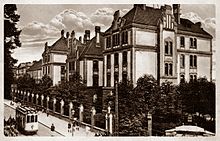
1905: Barracks Werderstraße

Open-air stage Schwerin during the BUGA 2009

Commemorative plaque for the protest march on 23 October 1989
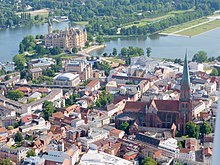
Aerial view of Schwerin

Newly designed prefabricated housing on Großer Dreesch as part of the Stadtumbau Ost urban redevelopment project
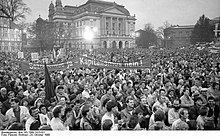
Rally at the Old Garden in October 1989

Three different building eras on the Great Moor

Sports and Congress Hall in September 1964

Grand Duke Friedrich Franz IV awards Fokker the Mecklenburg Cross of Merit at the airfield in Görries (1916)

Memorial for the victims of the death march southeast of Schwerin in Raben Steinfeld
.jpg)
The new court theatre 1885
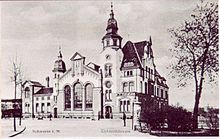
Electricity plant 1904

First station building 1847
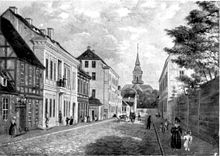
Amtstraße 1839
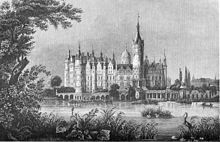
The castle around 1850
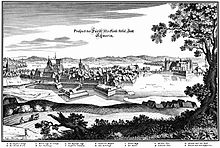
Schwerin before 1651

Schwerin around 1750
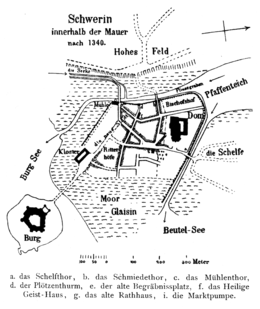
City map of Schwerin after the construction of the city wall in 1340
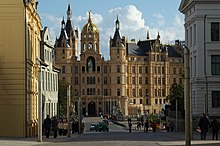
Schwerin Castle, seat of the state parliament of Mecklenburg-Western Pomerania, seen from the Old Town
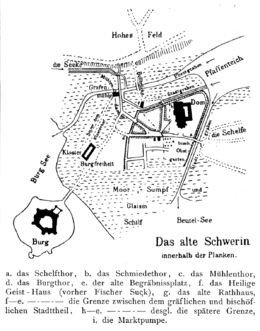
City map of Schwerin before 1340

Remains of the city wall

Seal from 1255: equestrian figure of the city's founder, Henry the Lion
Search within the encyclopedia